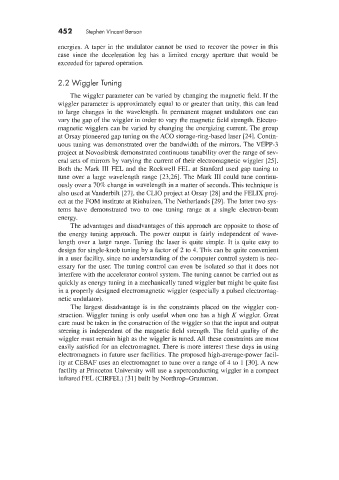Page 492 - Tunable Lasers Handbook
P. 492
452 Stephen Vincent Benson
energies. A taper in the undulator cannot be used to recover the power in this
case since the deceleration leg has a limited energy aperture that would be
exceeded for tapered operation.
2.2 Wiggler Tuning
The wiggler parameter can be varied by changing the magnetic field. If the
wiggler parameter is approximately equal to or greater than unity. this can lead
to large changes in the wavelength. In permanent magnet undulators one can
vary the gap of the wiggler in order to vary the magnetic field strength. Electro-
magnetic wigglers can be varied by changing the energizing current. The group
at Orsay pioneered gap tuning on the ACO storage-ring-based laser [24]. Contin-
uous tuning was demonstrated over the bandwidth of the mirrors. The VEPP-3
project at Novosibirsk demonstrated continuous tunability over the range of sev-
eral sets of mirrors by varying the current of their electromagnetic wiggler [25].
Both the Mark I11 FEL and the Rockwell FEL at Stanford used gap tuning to
tune over a large wavelength range 123,261. The Mark I11 could tune continu-
ously over a 70% change in wavelength in a matter of seconds. This technique is
also used at Vanderbilt [27], the CLIO project at Orsay [28] and the FELIX proj-
ect at the FOM institute at Rinhuizen. The Netherlands [29]. The latter two sys-
tems have demonstrated two to one tuning range at a single electron-beam
energy.
The advantages and disadvantages of this approach are opposite to those of
the energy tuning approach. The power output is fairly independent of wave-
length over a large range. Tuning the laser is quite simple. It is quite easy to
design for single-knob tuning by a factor of 2 to 4. This can be quite convenient
in a user facility, since no understanding of the computer control system is nec-
essary for the user. The tuning control can even be isolated so that it does not
interfere with the accelerator control system. The tuning cannot be carried out as
quickly as energy tuning in a mechanically tuned wiggler but might be quite fast
in a properly designed electromagnetic wiggler (especially a pulsed electromag-
netic undulator).
The largest disadvantage is in the constraints placed on the wiggler con-
struction. Wiggler tuning is only useful when one has a high K wiggler. Great
care must be taken in the construction of the wiggler so that the input and output
steering is independent of the magnetic field strength. The field quality of the
wiggler must remain high as the wiggler is tuned. All these constraints are most
easily satisfied for an electromagnet. There is more interest these days in using
electromagnets in future user facilities. The proposed high-average-power facil-
ity at CEBAF uses an electromagnet to tune over a range of 4 to 1 [30]. A new
facility at Princeton University will use a superconducting wiggler in a compact
infrared FEL (CIRFEL) [31] built by Northrop-Grumman.

